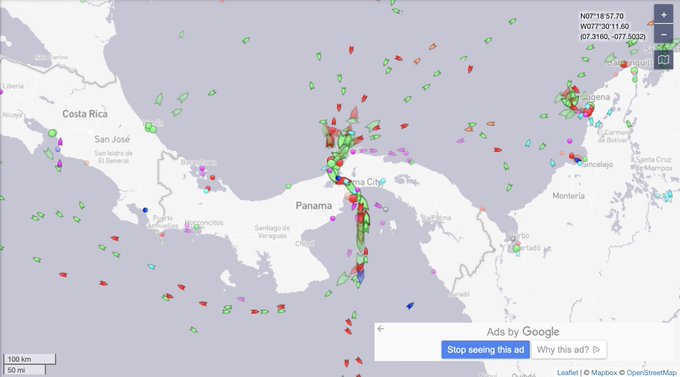The Problem with Space Pirates

At about 1:30 PM ET yesterday, Dr. Jessie Christianstein, a NASA researcher, tweeted the picture above saying, in part, that “some[where] in here is a $10B space telescope.” And she was, of course, correct. At some point over the last couple of weeks, workers at aerospace company Northrop Grumman put the James Webb Space Telescope (“JWST,” because that’s a lot of typing otherwise) onto a ship off the coast of California. From there, the telescope was to voyage down the Pacific to the Panama Canal (mapped above). Once entering the Atlantic, the ship will sail around the northern edge of South America to French Guiana, where — if all goes well — authorities from three space agencies — NASA, ESA, CSA — will take the space telescope and get it ready for launch. And on December 18, 2021, the JWST will be brought into space.
If that happens — and hopefully, it will — it will have been a long time coming. The JWST project was first conceived in 1996, with a target launch date of sometime in 2007 and a budget of $500 million. But we missed those targets. The telescope, per NASA, “will be the largest, most powerful and complex space telescope ever built and launched into space. It will fundamentally alter our understanding of the universe,” so it was important to get everything right. Seventeen delays, an extra fourteen years, and about $9 billion later, we’re finally on the cusp of getting the space telescope where it belongs: in space.
So for those who have been following the JWST project, it makes sense that you’d be watching marine traffic maps, waiting with bated breath as the ship carrying the very expensive object to its final terrestrial destination. But as Dr. Christianstein’s full tweet points out, you may find a hard time locating the specific ship. Not only are there a lot of ships in the image, but, as Dr. Christianstein notes, there may be some decoy JWSTs out there, too.
Yes, decoys. Why? Pirates!
When you think of pirates, you probably are thinking of Blackbeard or Calico Jack, or maybe some fictional characters like Captain Jack Sparrow, Long John Silver, or even Captain Hook. Either way, the picture you have in your head is of someone who either never existed or did so centuries ago. But piracy is still a real problem today. Per Statista, nearly 200 ships were attacked by pirates last year alone, and there have been more than 2,500 such attacks over the last decade. It’s a minor risk, all things considered, but it’s still a real one.
And it’s one that NASA decided it had to account for. With a weight of only about 14,000 pounds while on Earth, it wouldn’t be all that hard for a modern-day Blackbeard to commandeer the ship and steal the treasure. And it wouldn’t be the first time thieves have taken astronomical equipment and demanded an astronomical ransom, as the Atlantic recounts:
One of the earliest known calamities of this category occurred at the Allegheny Observatory, in Pittsburgh, in 1872. The astronomer Samuel Langley, the observatory’s director, had just returned from a conference when his employees rushed him to the top of the building. The lens of the observatory’s telescope had been stolen. “The story goes that Langley receives a letter in the mail from the foul fiend, and he says, ‘Meet me in the woods behind the observatory at midnight, or you’ll never see your lens again,’” Lou Coban, the observatory’s manager, told me. Langley and the thief met and “argued into the night”; the astronomer refused to pay the thief’s ransom, believing that it would spur “lens-napping” at other institutions. Langley managed to persuade the thief to divulge the location of the lens in exchange for keeping the man’s identity out of the papers. The hardware was found stuffed in the trash behind a nearby hotel, so scratched up that the observatory had to send it off for repairs.
While the bad guys didn’t get away with it in the story above, the damage was still very real (and besides, the pirates could just strip the JWST for its parts if they wanted to avoid the ransom route). So NASA and the other space agencies are taking measures to make that less likely. In 2018, according to Aerospace America, the space agency was considering giving the transport ship a U.S. Navy escort, and to some degree, that’s probably happening today — although details are understandably under wraps. Regardless, that’s not the only countermeasure. First, few people know when the JWST left California; as Scientific American reported, the “exact date of departure has been kept under wraps to stifle piracy.” And, again, it’s likely there are a couple of decoy ships making the same journey, just in case some of the details end up leaking out into the wrong hands.
That said, if you want to track the ship — or perhaps, a decoy version — you can pretty easily. There are lots of people trying to do so (hobbyists, not pirates, one hopes); here’s one example.
Bonus fact: Another option that NASA may have considered but probably isn’t employing is the Britney Spears System to Avoid Being Captured by Pirates, which isn’t the real name for the tactic but should be. As Time reported in 2013, that’s what the Royal Navy was doing to ward off Somali pirates when off the Horn of Africa: “Her songs were chosen by the security team because they thought the pirates would hate them most,” merchant Navy officer Rachel Owens told the publication. “These guys can’t stand Western culture or music, making Britney’s hits perfect.”
From the Archives: Patch Theory: The leading theory on why pirates used to wear eye patches.
